|
|
|
|
Several gibbon species are threatened by imminent extinction in the very near future. Gibbons not only include the most endangered apes but also the most endangered primate species of the world. The main reasons for this are habitat loss and degradation, hunting and illegal trade. Preservation of the tropical forest is imperative to gibbon survival - if it disappears, so do the gibbons. In China, for instance, the gibbons have already lost 99% of their habitat. In addition, they are hunted for food and for use in local medicine. Also, the illegal pet trade is thriving across the whole of Southeast Asia. Young gibbons are popular pets, but in order to obtain a young animal, its mother must be shot down from the tree tops. Often both mother and infant are killed in this process.
There are some protected forest areas, but often they are poorly managed and wildlife laws are not enforced effectively. Rural poverty and lack of awareness of the threats facing the gibbons and their forests are additional causes for inadequate gibbon protection. Lack of information is not just a local problem - the threats faced by the gibbons are largely unknown on an international level. Their current status is extremely alarming (see below), for example the rarest species of ape in the world is the Hainan crested gibbon, of which there are less than 30 individuals remaining.
The GCA therefore aims to promote awareness, research and conservation measures for the gibbons. Would you also like to do something to help the gibbons? Then support our work by donating or becoming a member!
| Species |
Estimated |
|
| Hainan Crested Gibbon | Nomascus hainanus |
35 |
| Cao-Vit Crested Gibbon | Nomascus nasutus |
100 |
| Black Crested Gibbon | Nomascus concolor |
1'300-2'000 |
| Javan or Silvery Gibbon | Hylobates moloch |
4'000-4'500 |
| Kloss's Gibbon | Hylobates klossii |
20'000-25'000 |
| Pileated Gibbon | Hylobates pileatus |
>47'000 |
| Mueller's Bornean Gibbon | Hylobates muelleri | 70'000 |
| Western Hoolock | Hoolock hoolock |
80'000- 110'000 |
| White-Bearded Gibbon | Hylobates albibarbis |
115'000 |
| Dark Bornean Gibbon | Hylobates funereus |
120'000 |
| Eastern Hoolock | Hoolock leuconedys |
unknown |
| Gaoligong Hoolock | Hoolock tianxing | unknown |
| Gray Bornean Gibbon | Hylobates abbotti |
unknown |
| Agile Gibbon | Hylobates agilis |
unknown |
| White-handed Gibbon | Hylobates lar |
unknown |
| Northern Yellow-Cheeked Crested gibbon | Nomascus annamensis |
unknown |
| Southern Yellow-Cheeked Crested gibbon | Nomascus gabriellae |
unknown |
| Northern White-Cheeked Crested Gibbon | Nomascus leucogenys |
unknown |
| Southern White-Cheeked Crested Gibbon | Nomascus siki |
unknown |
| Siamang | Symphalangus syndactylus |
unknown |
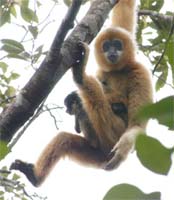 |
Hainan Crested Gibbon (Nomascus hainanus)The Hainan Crested Gibbon only occurs on the island of Hainan in the South-Chinese sea. As in all crested gibbons (genus Nomascus) the fur of adult males is black, that of adult females is yellowish. The species has already lost more than 99% of its original habitat. About 35 indiviudals of this species survive in the Bawangling National Nature Reserve, i.e. in the last piece of forest where this species is known to occur. This gibbon is, therefore, the rarest primate species of the world. |
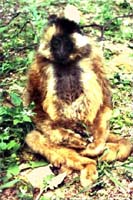 |
Cao-Vit Crested Gibbon (Nomascus nasutus)The eastern black crested gibbons only survives in one forest area extending from northeastern Vietnam (Cao Bang Province) to neigbouring China (Guangxi Province). The species has already lost more than 99% of its original habitat. Only about 100 individuals survive in the last piece of remaining habitat. This gibbon is, therefore, the second-rarest primate species of the world. |
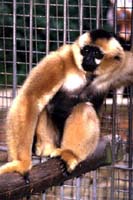 |
Black Crested Gibbon (Nomascus concolor)The western black crested gibbon occurs in southwestern China, northwestern Laos and nothern Vietnam. Only few relict populations still occur in this region, and only about 1'300-2'000 individuals survive. This species is critically endangered of extinction. |
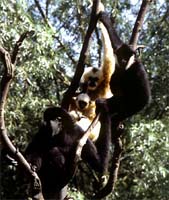 |
Northern White-Cheeked Crested Gibbon (Nomascus leucogneys)The Northern White-Cheeked Crested Gibbon is distributed in northern Vietnam and northern Laos. It orignally occured in the southernmost part of China's Yunnan Province, too, but became extinct there around the year 2000. Although no population estimate is available for this species, it is continuously disapearing from one known locality of its distribution area after another. This species is critically endangered of extinction. |
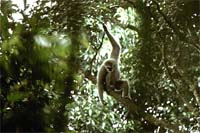 |
Javan or Silvery Gibbon (Hylobates moloch)The silvery gibbon only occurs on the Indonesian island of Java. The species has already lost 98% of its original habitat. Only few relict forests remain in west and central Java. Depending on the estimate only about 4'000 bis 4'500 silvery gibbons survive. The silvery gibbon is endangered of extinction. |
![]()
Website of the Gibbon Conservation Alliance